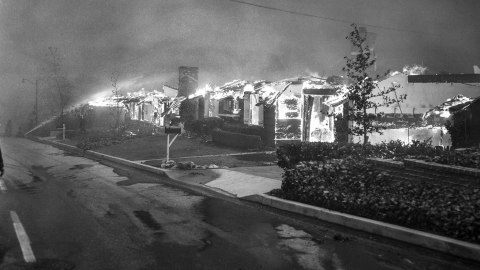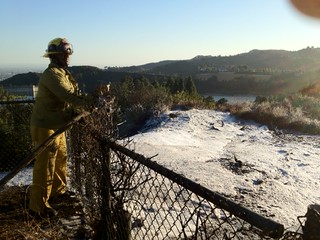Remembering the Bel Air Fire of 1961 as the Skirball Fire Rages
December 7, 2017 § 2 Comments

Roscomare Road, Bel Air, During the 1961 Fire, courtesy LA Times Archive
Waking to the news that the Sepulveda Pass was burning yesterday, I immediately thought of the last major wildfire to hit the area. On November 5th, 1961, the Bel Air Fire raced through the Hollywood Hills, burning 16,000 acres and destroying 484 houses. Though there were no fatalities, it was the largest fire to strike the City of Los Angeles, unrivaled until the current one began late Tuesday night.
The Bel Air and Skirball Fires began in similar conditions: fires from ignited brush were spread by Santa Ana winds at the end of an unusually long dry season. Without measurable precipitation or humidity, both catastrophes progressed quickly, flames racing from canyon to canyon along the ridge line of the Santa Monica mountains.
In Beachwood Canyon, the 1961 fire claimed 17 houses, including that of the writer Aldous Huxley and his wife Laura. When I interviewed Laura Archera Huxley in 2007, she vividly remembered being mesmerized by the flames near their house on Deronda Drive. Unable to grasp the urgency of the situation, she and Aldous waited too long to evacuate and lost nearly all their possessions as well as their home.
The Skirball Fire is being blown west instead of east, so Beachwood Canyon isn’t in danger from it. But bone dry conditions combined with tourists who smoke with impunity near the Hollywood Sign puts those of us who live here in constant jeopardy. When I learned that firefighters from our area were being deployed to fight the Skirball Fire, I started packing my bags.
Twenty-four hours later, the situation seems to be improving. But until this winter’s rains begin, fire danger remains, as does our fear. Visitors who ignore Beachwood Canyon’s No Smoking signs should know that all it takes is a single flick of a cigarette to destroy homes and lives. For those who don’t care, there’s a hefty fine for smoking. Let’s hope the City enforces it.
Related articles:
Setting Our House on Fire: Hollywood Sign Tourists and Their Cigarettes
Setting Our House on Fire: Hollywood Sign Tourists and Their Cigarettes
July 22, 2012 § 6 Comments
Around 6pm on Monday, July 9th, fire trucks roared up Beachwood Drive, setting off a chorus of howls among the Canyon’s coyotes (as well as a certain rescue dog who, I discovered, can howl while she walks). The LAFD was responding to a brush fire that started when a tourist tossed a cigarette into the dry brush at the Lookout on Canyon Lake Drive. This careless action–made in spite of No Smoking signs at site–threatened hundreds of homes, which is why 75 firefighters were deployed to extinguish it. Here’s an LAFD photo of the aftermath:
As someone who not only lives in the Canyon but spends time at Lake Hollywood Park, just below the lookout, I wasn’t surprised by the fire. I often see people, both tourists and Angelenos, smoking there, and they all do it with impunity. In the past couple of years, I’ve started telling smokers about the fire danger and asking them to put their cigarettes out; usually they do it without complaint. The only person who has refused, ironically, is an acquaintance of mine, who clearly felt I was overreacting because it wasn’t particularly hot or dry that day. Like most people, he didn’t think he could cause an accidental fire. One local woman takes cell phone photos of non-compliant smokers; when they ask why, she says so if there’s a fire I can show it to the police. I wish I could be so brave.
This might be a good time to remember the Hollywood Hills fire of May 12, 1961, which started at the northern edge of Beachwood Canyon and caused enormous devastation before it was extinguished the next day. An LAFD report by Inspector Otto Firgens reads:
Due to the heavy brush, high winds, low humidity and rugged terrain the fire developed into major proportions within 15 minutes of the original alarm. A Major Emergency was declared at 7:59 pm….The fire continued to burn out of control toward Mt. Lee and the Griffith Park Observatory to the east. It was spreading and had already developed a 4 or 5 mile perimeter. It raced up one canyon and down the other, driven by winds which at times reached 67 miles per hour.
In the end, 17 houses in Beachwood Canyon were either damaged or destroyed by the fire. Among the total losses was the home of Laura and Aldous Huxley. Because they left with only what they could carry, they lost not only most of their possessions but all of Aldous’s papers and manuscripts. The only manuscript Huxley saved was his book in progress, Island. Also burned to the ground was the home of their friend Ginny Pfeiffer. More than 50 years later, neither house has been rebuilt, though the Huxley property was sold after Laura’s death in 2007. The foundations of Pfeiffer’s house on Deronda Drive are visible to tourists trying to reach the Hollywood Sign, but I doubt anyone notices. Here’s what the fire left behind:
Additional source: LAFD archives
Remembering Laura Archera Huxley
May 22, 2011 § 5 Comments
When I began planning my documentary, “Under the Hollywood Sign,” in 2006, various Hollywoodland neighbors said, “You’re going to talk to Laura Huxley, of course.” Once I got over my disbelief that Aldous Huxley’s widow could be alive, it was simply a matter of sending her an email, which led to a phone conversation and an invitation to her house on Mulholland Highway.
Having been warned that Mrs. Huxley had lost much of her eyesight to macular degeneration, it was a shock that Sunday to discover her alone in the house with the front door was wide open. A tiny, elfin figure, she greeted me and said, “You are blonde, no?” before announcing there was a bird in the house, and that I would have to remove it.
A hummingbird was trapped in the double-height living room, banging desperately against the panes of an enormous arched window. I felt I had wandered into a Garcia Marquez novel. I also suspected my efforts wouldn’t succeed, given the size of the room and a previous experience with a trapped hummingbird, but said I would do my best. It was not a promising start, as the ensuing conversation was punctuated by her frequent commands to shoo the bird toward an open door in the dining room. Eventually, however, two miracles occurred: the bird flew out, and Mrs. Huxley agreed to an on-camera interview.
On the appointed day, I returned to the house with my camera crew. We had planned to do the interview outdoors, but it was far too windy, so while the DP began setting lights in the dining room, I explained to Mrs. Huxley that the interview would have to be held inside, away from the noise of the wind. She responded by refusing to be interviewed at all, claiming the lighting hurt her eyes. Having had similar experiences (always with elderly women) on my first documentary (“Jim Thompson, Silk King”), I had previously arranged to interview her assistant, Stephanie Horsley, about life in Hollywoodland during the 1960s. So I went ahead and interviewed Stephanie while Mrs. Huxley sulked in the living room. By the time we finished, she had changed her mind.
Unfortunately, it wasn’t smooth sailing from then on. Mrs. Huxley suddenly announced she wouldn’t sign my release without seeing the edited result. I now had the choice of canceling the shoot or going ahead, despite the possibility that she would never sign the release, rendering the interview unusable. It was a dilemma I hadn’t faced before. In the end, I did the interview, which yielded some good stories about her impressions of Hollywoodland and her life with Aldous Huxley. Afterwards, I went to the expense of editing a segment I might never be able to use, trying to anticipate far in advance of finishing the documentary which parts I might eventually need. Time was of the essence, not only because Laura Huxley was 95, but because she was terminally ill with cancer.
Fortunately, she later approved the segments and signed the release. By then, I had read her memoir, This Timeless Moment (Celestial Arts, 1968, 2000) and researched her long and remarkable life.
Born in Turin, Italy in 1911, Laura Archera was a violin prodigy who came to the United States to perform. Prevented by World War II from returning home, she came to Los Angeles with her companion, Ginny Pfeiffer, and played in the LA Philharmonic.
She also discovered Hollywoodland, which she loved for its nature and solitude, where she befriended Aldous Huxley and his wife Maria, who had left Europe in the late 1930s. After Maria died in 1955, Aldous and Laura grew closer, and surprised their friends by marrying the following year.
Although not literary like Maria, Laura shared Aldous’s philosophical adventuresomeness. Through a mutual interest in alternative medicine, the Huxleys became active in the counterculture of the late 1950s and 60s, befriending Timothy Leary and Ram Dass and experimenting with LSD. In our interview, Mrs. Huxley, while acknowledging that many young people were hurt by LSD, took a benign view of the drug. “Sometimes you have a hellish experience and sometime you have a heavenly experience….It’s like anything else, it’s what you do with it,” she said.
After giving up her music career, Laura Huxley began a theraputic practice and wrote books (such as You Are Not the Target) promoting self-healing through mental exploration. Later she turned her focus toward children, starting a foundation on their behalf. But she never escaped her association with LSD, particularly after she wrote about injecting Huxley with the drug, at his request, as he lay dying.
Aldous Huxley died less than eight years after their marriage, on date of President Kennedy’s assassination. At the time of Laura Huxley’s death in December of 2007, she had been his widow for 44 years and outlived most of her friends and associates, including Timothy Leary, Christopher Isherwood and even her stepson, Matthew Huxley. Still, her memorial service in 2008 offered many reminders of the 1960s, including a reading of her essay on Aldous’s final hours and a videotaped message from Ram Dass. Best of all, however, was the parting gift we attendees received: an LP of her therapeutic “recipes for living.” After dragging my turntable out of the garage and setting it up, I was startled to hear her heavily accented voice again, intoning, “Imagine that you’re completely surrounded by flowers…flowers far and near…an infinity of flowers….”–and to realize that I missed her.





You must be logged in to post a comment.